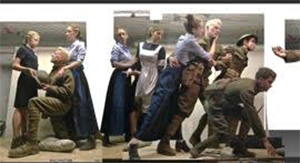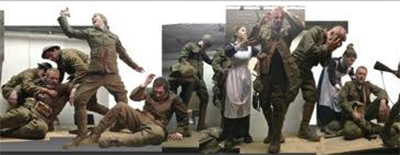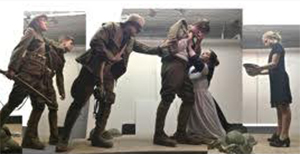Fine Art Today’s exclusive look into master sculptor Sabin Howard’s progress for the United States World War I Centennial memorial in Washington, D.C., continues. You won’t believe it!
Soon there will be a new national monument near the White House that will honor the more than 116,000 soldiers who died in World War I and the nearly 5 million individuals who served. Veteran sculptor Sabin Howard, along with 25-year-old architect Joe Weishaar, were awarded the commission, undoubtedly cementing Howard’s legacy as one of the nation’s top living artists.
Already extremely busy in his studio, Howard has graciously allowed a sneak peek into the monument’s design in addition to his thoughts behind the evolving composition. Earlier this summer, Fine Art Today initiated Part One of “Tracking History,” which gave our readers their first glimpse into the monument’s progress. Since then, Howard has made stunning advances in the design, which we are delighted to share with you here.
Commenting on his evolving monument, Howard offered this:
“A Soldier’s Journey” — by Sabin Howard
This is one soldier’s voyage through World War I as told through an emotionally charged visual narrative. The story unfolds over a 75-foot-long bronze relief, beginning on the right with all the characters moving at different speeds leftward, toward the future.

Detail from above, Image (c) Sabin Howard 2016
The figures are elevated two feet off the ground to give the composition a sense of monumentality as well as to show the immense, epic nature of World War I.
The soldiers, nurses, wives, and children all tell a story through their body language and poses. The relief will be sculpted in medium to low relief, giving a sense of drama and passion as the figures move out toward the viewer and then recede back into space away from us. The viewer travels the length of the wall from left to right and so witnesses and experiences the soldier’s journey.
The visual narrative has been structured with a beginning, a middle, and an end. Each section carries different emotions and kinetic energy. The relief carries a vital message about the suffering of war and how it affects all people.

Detail from above, Image (c) Sabin Howard 2016
The beginning of the relief speaks to the female experience of war; a woman is portrayed in three different scenes. The initial scene begins with the family and the connection of wife and children to the soldier’s life. A kneeling soldier, our protagonist, tenderly says goodbye to his child as she hands him his helmet. The wife stands stoically behind her husband, remaining strong for their child.
Moving to the right, the wife turns to grab a nurse. Her gesture asks the nurse to intercede on her behalf as a healing figure of war in the larger picture, through medicine and the healing arts. She is pleading: Please safely return her husband to her. In the next portrayal of the husband-and-wife, everything that she cannot show her child, but that she shares with her mate, comes out. She holds onto her husband with a feeling of abandonment and fear. The wife’s future is leaving her as her husband goes off to war with the other soldiers.
Entry into battle begins, and the story quickens. The soldiers pull forward and call other soldiers into action. Their heads turn from the home front toward the battlefield.

Detail from above, Image (c) Sabin Howard 2016
The central section of the relief begins with the battle scene. In the foreground, at the left, is a grouping of three soldiers. In the beginning of the scene, a young soldier kneels. He is still innocent. Our protagonist soldier has entered into battle; he has turned into an aggressor — he screams directly out at the viewer with rage. He clutches his fallen comrade’s tunic to his right. This is the result of war: death and loss.
The battle erupts with aggression. There’s an animalistic nature and chaotic force written on the faces of the soldiers as they surge forward toward a central figure on the right. This figure screams with aggression, his mouth open wide. His pistol is cocked and raised high toward the heavens. All emotional restraint has disintegrated.
Below this figure lie terrified soldiers, wounded and cringing. Then, wounded, the protagonist soldier appears again. He is aided by other soldiers toward the right in the scene.
The final scene, called “The Cost of War,” ends with a processional of wounded, emotionally damaged soldiers. Within this group there is one proud heroic soldier who carries a young man from the initial scene. In their pose, the young man he carries is almost a part of him. For even in victory, war exacts a terrible toll. They struggle toward the soldier’s child, who holds a helmet in her hands. Blind, shell-shocked, and emotionally and physically wounded soldiers all move toward this child. She represents the next generation, as she looks into her father’s empty helmet. This is the terrible cost of war.

Detail from above, Image (c) Sabin Howard 2016
This child begins the relief and ends the relief. Our protagonist soldier reappears here as a noble and heroic man. The soldier comes forward directly at you on the left. He brings with him the burden of war and the loss and madness that he has seen. He has gained wisdom through suffering. He has looked inside himself; there has been an internal examination on an individual level where he has seen incomprehensible things about humanity.
Our protagonist is helped by the nurse. In this scene, on a larger picture, she represents a moral compass. She holds up a mirror to war so humanity can see the devastation. On the personal level, she helps the wife by taking care of her husband in this devastation. Sisterhood, alongside the brotherhood of soldiers in arms, is implied.
Further to the right, in the last depiction, our soldier leans forward, blind and injured. His used gas mask dangles and despite his wounded arm, he fights to get back. Pushing forward, striving to reach the normalcy of the past, he presses on toward his daughter and the future.
This article was featured in Fine Art Today, a weekly e-newsletter from Fine Art Connoisseur magazine. To start receiving Fine Art Today for free, click here.







